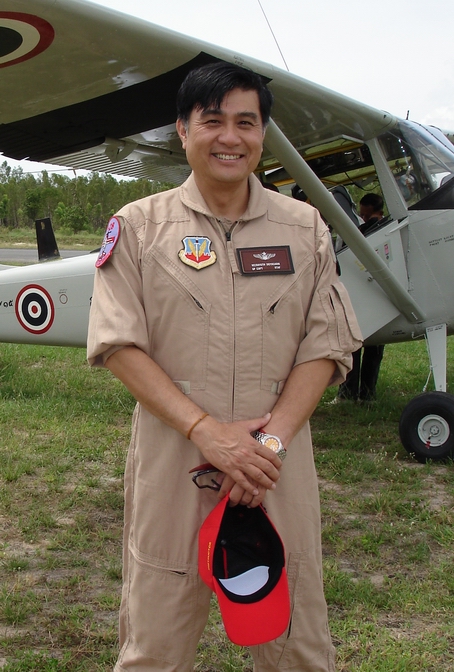Address
304 North Cardinal St.
Dorchester Center, MA 02124
Work Hours
Monday to Friday: 7AM - 7PM
Weekend: 10AM - 5PM
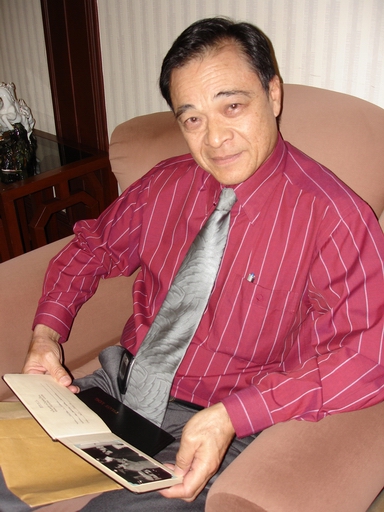
Khun Thira T. Suwan was involved with the Thai Flying Club from the very beginning. He was the first Treasurer of the club; he served 3 terms as President (from 1996 to 2002), and he holds Thai Private Pilot’s License #001. His love for flying began when he was 8 years old. His mother had taken him to visit a booth for the Royal Thai Air Force, and he subscribed to “Chang Agat” (the Thai Aviation Engineering Magazine). The following year he began control line flying of model aircraft in a small area near his family house on Soi Prompong in Bangkok. When he attended Grammar School in London at age 14, he persuaded the Catholic Priests to allow him to continue his control line flying in the school yard. The priests had never seen it before, and they were quite impressed. Khun Thira then went to America to attend Carnegie Institute of Technology in Pittsburgh. His father had started a printing business in Thailand, and he was enrolled at the Printing Technology Management School. He remembers that Pittsburgh was cold, and there was one other Thai person there. When he went one day to fly his control line model in a local park, the police stopped him. That was the end of his model flying in the USA. During his second year, he went with one of his roommates, Jim Wayland, to visit a nearby airpark. They took a 30 minute flight in a 60 H.P. Aeronca Champ. It cost US$5 per hour. He remembers England being “rather conservative” and his reflections on America were that it was huge place where people were free, happy, outspoken, outgoing, and he loved the non-stop music on the radio. Khun Thira had studied the Violin and the Piano, and continued the Piano at University. His interests were Tennis, Soccer, and Fencing. After completing his studies in 1963, he returned to Thailand to work in his family’s printing company with his father and his brother. He married and had some children, but flying was still in his mind. It was on a family holiday in Hua Hin, that he noticed some small aircraft landing at the airport there. He followed them and walked to the airport, and that is where he started to think.
He went to visit the R.T.A.F. (Civilian Flying Club) on the West side of Don Muang Airport. In those days there was only one runway and previously the club had used a Piper Cub and a Tiger Moth. This was the only place a civilian could fly. He was enrolled in class 21. He is first flight was on 09 July 1964, and his first solo on 22 August 1964 after a total of 6 hours 12 minutes flight time. It took over a year to finish, because often there were maintenance delays, but he received his “Graduation Certificate” from the Civilian Flying School in 1965. In 1974, The Singapore Flying Club hosted an Air Rally in which Adjan Krisda also attended. This was Khun Thira’s first flight in a twin Comanche twin engine aircraft. The Thai visitors would fly by commercial aircraft to Singapore and then rent the aircraft from the Singapore Flying Club. “During the Air Rally, we would have Spot Landing competitions (with power and without), then Navigation Exercises along a course to try to find pictures of landmarks, and we also be tested on the Rules.” In 1976, Khun Thira hRTAF Chipmonks at Don Muang Airport in Bangkokad his first flight in a Cessna 150 at Hua Hin. “After 12 years of flying Chipmunks, some of us (Khun Chusak, Khun Payom, Khun Thira, Dr. Tawin, Khun Prasom, and others) felt that we would like to get our license for private aircraft.” Kruu Krasin was the director of the flying in Hua Hin, and he was one of the nicest people you could ever meet. He was very supportive and helped with transition training. They would organize the ground school in Khun Thira’s house – a total of 120 hours – during the weekends. They applied for an exam at the DCA and a Flight Exam at Hua Hin. Their class was not the first; there had been 2-3 before them. They all received their Private Flying Licenses, but there was no where to use them. Khun Prasom was very much at the forefront at this time. There was a Cessna 150 available, possibly from Laos, and they got together with the R.T.A.F. Civilian Flying Club and bought the plane and donated it to the club with military registration. At that time, no private person could own an aircraft, and it occurred to us that to form a club (association) was the way to go.
They submitted and registered with the Ministry of Education an “Association” (no privileges – only the name). The next step was to contact the DOA. In the back of their mind was security. They were requested to submit “Rules and Regulations” for their Association which outlined the purpose, the details, and how they planned to control and organize the club. Kruu Krasin was still the Director of CATC (Civil Aviation Training Center) in Hua Hin, and he was 200% supportive of the project. The DOA looked up to him. After 3 years of paperwork (through several Cabinets) special authorization was issued to start operations. Only TFC had such a privilege (because this occurred on a case-by-case basis). Khun Prasom couldn’t wait. He went shopping for aircraft in Arizona, USA and found two used aircraft – two Cherokee 140 aircraft at $14,000 for both. Now that they had the Association going, let’s buy the two aircraft and get going. Kasikorn Thai Bank authorized the loan, and the two aircraft were shipped to Hua Hin. The CATC mechanics helped to assemble the aircraft and the DOA issued a special permission to test fly the aircraft. Most of the DOA were supportive of the idea to fly. After that we were still waiting. Khun Prasom got to know the Commanding Chief of the Army Aviation Center in Lopburi, Major General Sathien Nilkamhaeng (Soon Gan Bin Tahan Bok), who was very nice and supportive. We were blessed, right from the beginning, and he was a pilot too. The Army took us in and let us fly there. There pilots would fly in our aircraft too, and thus the Aircraft Evaluation Program was born and the two aircraft were named “Army 1001” and “Army 1002.” This was at the “SaPranNak” Army Airfield (8 NM North of the RTAF KoKraThiem Lopburi Airfield).
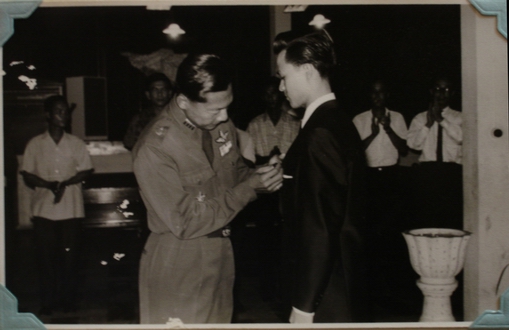
It was 17 December 1976 when Khun Thira received his Thai PPL license. It was one day in June 1979 when Khun Prasom and one Army Major flew the two Cherokee 140 aircraft from Hua Hin to Lopburi. (These aircraft are now still flying in Thailand – Army 1002 is now HS-ATK owned by Khun Wichai Laksanakorn and Army 1001 is now HS-ATJ owned by Thai Flying Club). The club now had 30-40 members and they were flying every weekend up in Lopburi. Khun Thira bought his first aircraft – a Grumman AA5B (partners: Thira, Opas, Krisda, and Khun Charatpong Suriyothai). It arrived in Hua Hin in August 1979 and became “Army 1003” (this aircraft is now owned by Khun Preecha). It was a fast, light, responsive airplane with a good view. “Now, we could go ANYWHERE.” No prior permission, no landing fees. We flew to Chiangmai, Chiangrai, Hat Yai, Kanchanaburi, Phuket. Our fuel range was 4 hours at 115 knots. The only thing we had going was the ADF. We flew by Dead Reckoning and Pilotage.” Khun Thira recalls one difficult flight when he flew from Lopburi to Chiangmai via Phumibol Dam. It was hazy with 1-2 miles visibility. The ADF was wandering and for 20 minutes, he was lost. He switched to the AM radio station in Chiangmai, and he was able to make it. The AM radio stations were very helpful in those days. The Thai Flying Club was based in Lopburi for 4 years from 1979-1983.
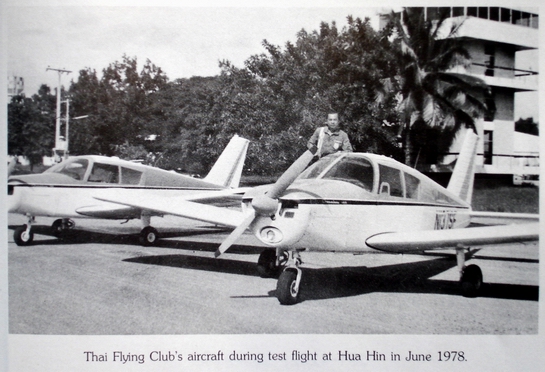
The President of the club was Air Marshall Fuen. He was close to 90 years old, but his heart was in flying. He was 1,000% supportive of us. He was the founding president of the club, and he never missed a meeting. We had monthly meetings for almost 10 years. The club grew to over 100 members on paper. It used to take 2.5 hours to drive from Bangkok to Lopburi. Our biggest event was our 3rd Air Rally in 1980 to Phuket. We had our 3 Army club planes, 3-4 planes from CATC, 4-6 planes from the Air Force, and about 10 planes from Malaysia and Singapore. We had about 20 planes in all. We flew over the city of Phuket and dropped leaflets about the Air Rally. 10,000 people came to the airport. We had problems with crowd control during the flour bombing. This was the first large Civilian Flying Event in Thailand. During the last day of the Air Rally in Phuket, on Sunday, the front page of the Bangkok Post read “Cabinet Approves Thai Flying Club.” This was the first we heard of it, so in December 1980, we received our permission. Now, the TFC could own and operate aircraft. The next episode was Bang Phra.
Khun Prasom got to know the head of Rajamangala Institute of Technology. Prasom was the Secretary General from the day the club was formed, and he was really fantastic at getting to know people and to convince them of what he wanted. Professor Doctor Adjan Saward Chaikuna was the Rector of the Institute. He was a part-time pilot who flew in USA and was very sympathetic to the club. The Institute had a beautiful campus in Bang Phra with plenty of land, and the InBang Phra airstrip in the early days (photo courtesy of Khun Thira)stitute was thinking about Aviation Agricultural Research. The Thai Flying Club was given permission to build the runway and to operate there. The institute would keep an aircraft there for Aerial Agriculture Operations. This C-150 is still based at the club.
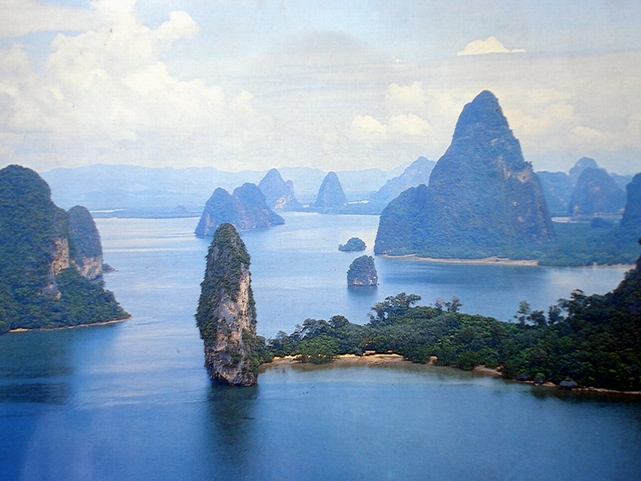
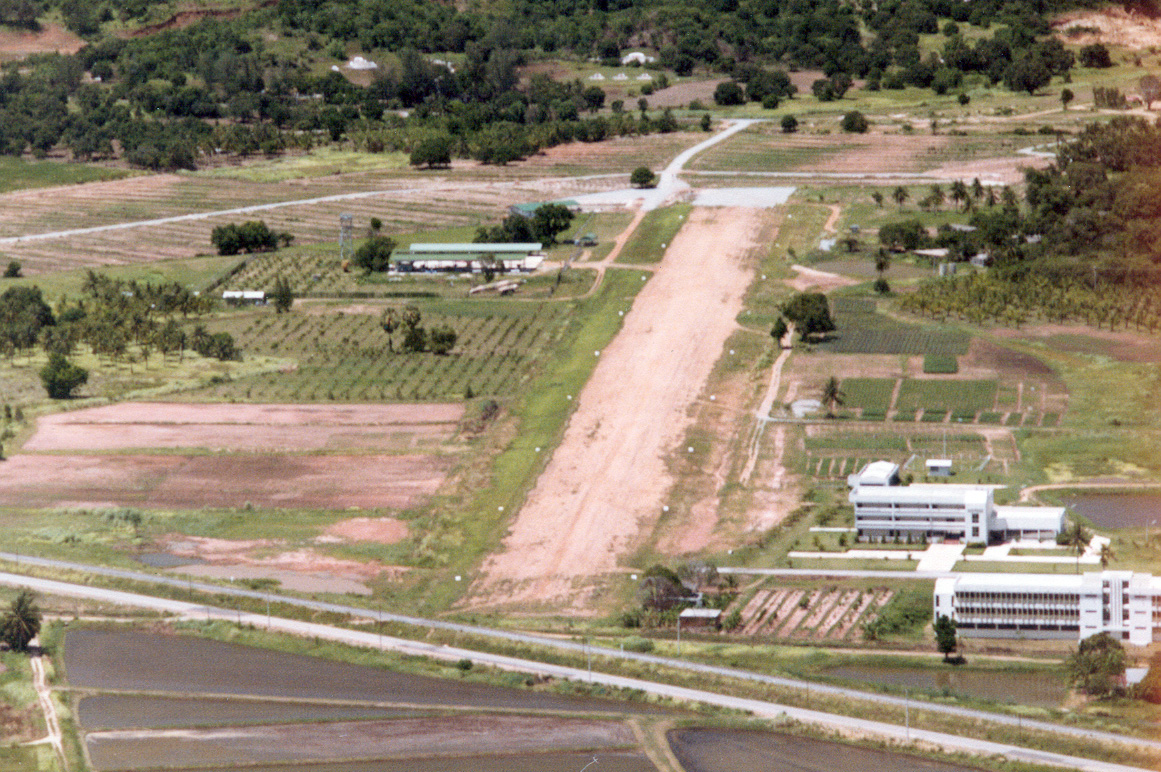
On 13 May 1983, the first Civilian Aircraft landed in Bang Phra. Khun Prasom had gone to Singapore and bought out a club that was closing. The Thai Flying Club bought four C-150’s and two Cheetahs. The Thai DOA went down to Singapore and registered them (4 C150s: HS-ATC, HS-ATD, HS-ATE, HS-ATF, and 2 cheetahs: HS-ATI, HS-ATH). Khun Charatpong, Chusak, Thira, Prasom, Krisda, Opas went and flew them back from Seletar via Penang, Hat Yai, Surat, Hua Hin with a 5-10 minute spread between each. Five of them landed in Penang, but Khun Charatpong in the C-150 was still missing. The aircraft finally landed 1 hour late. He had accidentally set his heading to 035* after take off, rather than 350* until he asked himself “what is the sea doing on my right?” The ATC kept calling him, but he kept quiet. These were the first 6 aircraft and they landed in Bang Phra on Runway 23 on 13 May 1983. Then on 18 June 1983, Army 1001, Army 1002, Army 1003 arrived from Lopburi (and became HS-ATJ, HS-ATK, HS-ATG). These were the first 9 aircraft in Bang Phra. There was one hangar and a laterite strip. Every cross country flight needed prior permission from the DOA which took about 2 weeks to obtain.
The next milestone was for the government to allow private ownership of aircraft. Khun Prasom, Thira, Wichai all had to work hard to persuade the DOA to allow private ownership. Khun Virayudth Didyasarin was very helpful at this time. He was highly respected in Thailand, and it was his idea that the government should look at the development of the aviation industry in Thailand as a whole and not a case-by-case basis. He organized 3 seminars (2 of which were in November 2538 (Buddhist era) and January 1995). This included the Minister of Communication and were to build up support and open discussion. Everybody was there. The seminars raised interest in the Government sector. Prime Minister Anand’s government approved in Parliament and it became law, but with some strings attached – owners had to be Thai Nationals, and they had to obtain 5 year Permits for Operating their aircraft. This allowed the government to maintain control that they felt comfortable with. In practice, the club is free, except for the request for flight clearance. After a few more years of good relations and meetings with DOA and Director General, they allowed us to fly cross-country without prior permission.
In 1988, Khun Thira bought his TB-20 Trinadad retractable gear aircraft. In the early 1990’s DOA stopped the regulation for prior cross-country clearance. The DOA did request that Bang Phra have an ATC, so we hired a part-time ATC from Bangkok to handle air traffic control on the weekends. The Thai Flying Club has had a tremendous effect on the development of General Aviation in Thailand. “We started everything rolling.” Khun Thira is very humble about the achievements of the club, but it is very obvious that GeneralOld map of Siam Aviation would not have progressed as fast nor as far in this time frame without these special pioneers. Khun Thira feels that their early objectives were “to let everyone enjoy the skies as they wish.” That goal has been achieved. Khun Thira shared that flying has taught him to be careful, follow rules, and always have a way out for emergency. The club developed the idea for the “Winter Tour” as a social activity, for enjoyment, but also to share costs and enable everyone to gain experience. Being involved with flying for most of his life as a hobby has given him a different outlook and perspective: “Once you’re up there, it will change you. I love the freedom of movement. It makes me want to share flying with others.” Khun Thira loves ultralights, especially with high fuel costs, and he is thankful that the DCA has let it go and is allowing the development of ultralight flying in Thailand. His greatest flying memory was his first flight to Phuket over Pang Nga. It was so beautiful. During the years he has flown in Thailand, he has noticed some changes on the ground. “It is so sad to see those hills and jungles up north deforested. It is very sad and very noticeable.” Khun Thira’s greatest flying mentor was Kruu M.R. Kampoon Thongthem (Dep. Director CATC in Hua Hin when he first went for his PPL). He taught me the importance of CHECKLISTS and to FOLLOW THEM.
ERRATA: from Khun Thira (18feb2010) — Thanks for your e-mail but some facts need to be cleared. Although my license number is no.1, it was not the first PPL issued. In fact, I was probably the 5th or 6th I’m not sure. It was however the first of this new PPL format issued bu the DOA. I would be embarrassed if people were led to believe that I was the first private pilot in Thailand. To find out who was the real first PPL, you would have to ask the DOA. Another error, Kru Krasin was not the director of CATC. He was the chief of the flight training division of the CATC.
